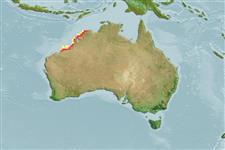>
Clupeiformes (Herrings) >
Dorosomatidae (Gizzard shads and sardinellas)
Etymology: Herklotsichthys: After Janus Adrian Herklots, Australian ichthyologist, 1820-1872.
More on author: Whitley.
Environment: milieu / climate zone / depth range / distribution range
Ecologia
marino; distribuzione batimetrica 0 - 50 m (Ref. 188). Tropical; 14°S - 21°S, 118°E - 127°E (Ref. 188)
Eastern Indian Ocean: Western Australia. The western counterpart of Herklotsichthys castelnaui and possibly merely a subspecies.
Size / Peso / Age
Maturity: Lm ? range ? - ? cm
Max length : 10.5 cm SL maschio/sesso non determinato; (Ref. 188); common length : 8.0 cm SL maschio/sesso non determinato; (Ref. 188)
Spine dorsali (totale) : 0; Raggi dorsali molli (totale) : 13 - 21; Spine anali: 0; Raggi anali molli: 12 - 23. Distinguished from most other Australian Herklotsichthys by lacking spots on the flank and lacking elongate wing-like scales underneath the normal paired pre-dorsal scales. Most closely resembles H. castelnaui but has fewer lower gill rakers. Separated from H. gotoi and Herklotsichthys Species C by its black tips to caudal fin and 3 distinct dark lines along upper flank.
A schooling species found in coastal waters (Ref. 188, 75154).
Life cycle and mating behavior
Maturities | Riproduzione | Spawnings | Egg(s) | Fecundities | Larve
Whitehead, P.J.P., 1985. FAO Species Catalogue. Vol. 7. Clupeoid fishes of the world (suborder Clupeoidei). An annotated and illustrated catalogue of the herrings, sardines, pilchards, sprats, shads, anchovies and wolf-herrings. FAO Fish. Synop. 125(7/1):1-303. Rome: FAO. (Ref. 188)
IUCN Red List Status (Ref. 130435)
Threat to humans
Harmless
Human uses
Pesca: pesca di sussistenza
Strumenti
Special reports
Download XML
Fonti Internet
Estimates based on models
Preferred temperature (Ref.
123201): 26.8 - 28.6, mean 28 °C (based on 46 cells).
Phylogenetic diversity index (Ref.
82804): PD
50 = 0.5002 [Uniqueness, from 0.5 = low to 2.0 = high].
Bayesian length-weight: a=0.00912 (0.00433 - 0.01920), b=3.04 (2.87 - 3.21), in cm total length, based on LWR estimates for this (Sub)family-body shape (Ref.
93245).
Trophic level (Ref.
69278): 3.1 ±0.3 se; based on size and trophs of closest relatives
Resilienza (Ref.
120179): Alto, tempo minimo di raddoppiamento della popolazione meno di 15 mesi (Preliminary K or Fecundity.).
Fishing Vulnerability (Ref.
59153): Low vulnerability (10 of 100).
